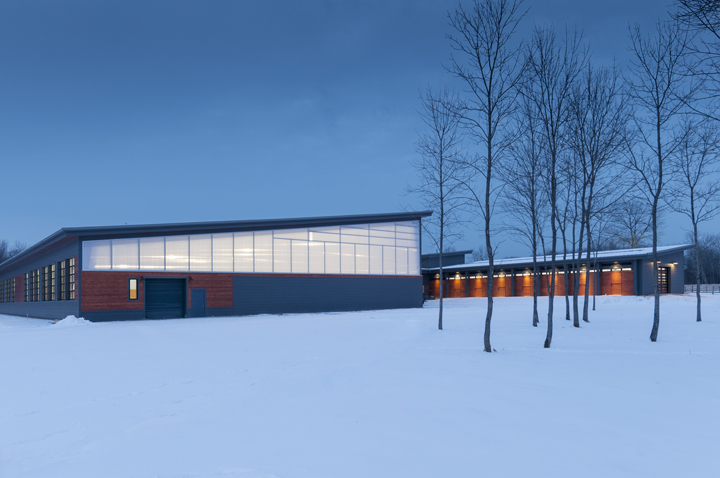Blackburn Architects’ Senior Project Manager Ian Kelly answers questions about the glass used in equestrian facilities.
Q: Dear John,
I’m overseeing renovations to a barn in the cold climate near Quebec. To improve the barn’s functionality, safety and ventilation, we are converting the windows to double-pane, energy efficient, glass.
Please help:
1. Do you recommend a pane of tempered glass on one side of the spacer bar and regular laminated glass on the other side? (Editor’s note: a spacer bar, sometimes known as a profile, is the continuous hollow frame which separates the two glass panes in a double glazed window.)
2. Is it better to have tempered glass throughout including the laminated glass?
3. It appears that laminate glass consists of a clear plastic laminate sandwiched by glass on both sides. Do both glass pieces that make up the laminate glass need to be tempered?
4. Do both panes of glass making up the double glazed unit need to be laminated?
5. What minimum thickness of glass and minimum airspace or spacer bar size do you recommend?
Thanks so much for your help,
Barn Manager Trying to Get It Right
A: Dear Barn Manager Trying to Get It Right,
1. We recommend that the glass used in equestrian structures be tempered throughout, including the glass that is laminated. The tempering and lamination processes do separate but similar things: They create safer glass for people and livestock. Tempering makes the glass break into small chunks as opposed to slivers and sharp pieces, while the lamination gives the glass a slightly greater resistance to breaking, and keeps the glass in place when and if it breaks. Both serve to make it safer around the horses if a window should break.
2. If horses have access to both sides of the glazing unit, then we recommend both sides of all glass should be laminated and tempered. If cost is an issue, I would stick with everything being tempered and omit the lamination. I say this because laminated glass does not always age as well as tempering. This doesn’t happen in every case, but the laminate can shrink and pull in from the corners of the glass, and eventually become visible over time. We prefer tempering.
3. Any glass that is exposed to the horses should be either tempered or laminated at a minimum. If the horses have access to both sides of the doors, yes, both panes should be protected in one way or the other, or both.
4. You should work backwards from the depth of frame that you have, minus about 1/4”. Working with the glass manufacturer will determine what they have available for the spacer sizes. The more airspace you can allow for the better, but each manufacturer already works with a few different size spacers. Use the largest one that still allows the glazing unit to fit within the frame.
You also should consider some other factors pertaining to glass in cold climates, and request glass that meets the following:
You want glass with a high solar gain, and low emissivity.
1. The glass should have a Solar Heat Gain Coefficient (SHGC) around 0.55
2. The glass should have a U-value of less than 0.33
3. The glass should have a higher value Visible Transmission (VT)
4. Use double-paned glazing unit with low-e gas that has a vacuum sealed gasket between the panes of glass. The pocket between panes of glass is filled with an insulation gas, most typically argon.
5. You may also consider using low emissive (low-e) glass panes. Low-e prevents the transfer of heat from warm to cold. So if you do, the low-e coating (typically a metallic oxide) should be on the outermost side of the innermost pane of glass.
There are pros and cons that should be considered with each option. For instance, with #4, over time and if the gasket seal fails, you can begin to see condensation between the panes of glass. Whereas with #5, you may be able to see the coating from certain angles, especially if you are wearing polarized sunglasses.
Since the advantages are a bit more obvious, and similar to one another (i.e. tempered vs laminated, and low-e gas vs low-e coated glass), here is a summary of some of the disadvantages to each option:
tempered only – glass may still shatter (in harmless pieces) and fall to the ground
laminated only – laminate can discolor over time and shrink in from the corners of the glass
low-e gas filled glazing unit – if the gasket fails, condensation can form in between the glass
low-e coated glass – may be visible in certain light conditions, or when wearing polarized sunglasses. You can sometimes see this on automobile glass.
My suggested starting place would be tempered glass, meeting the SHGC and U-values recommended above. I would then lean toward #5 – low-e coated glass, since with #4 you can expect the gaskets to fail at some point, and then the glazing unit would need to be replaced again. If the coating of the low-e coated glass is too “visible”, then low-e gas may be the better option, with the expectation that you may need to replace some of them again in 10 to 20 years, if and when the gaskets fail.
